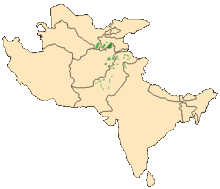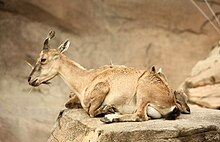Markhor
| Markhor | |
|---|---|

| |
| Male markhor in captivity at the Augsburg Zoo | |
| Scientific classification | |
| Domain: | Eukaryota |
| Kingdom: | Animalia |
| Phylum: | Chordata |
| Class: | Mammalia |
| Order: | Artiodactyla |
| Family: | Bovidae |
| Subfamily: | Caprinae |
| Tribe: | Caprini
|
| Genus: | Capra |
| Species: | C. falconeri[1]
|
| Binomial name | |
| Capra falconeri[1] (Wagner, 1839)
| |
| Subspecies | |
|
See text | |

| |
| Distribution of the markhor | |
The markhor (Capra falconeri)
The markhor is the
Description
Markhor stand 65 to 115 centimetres (26 to 45 in) at the shoulder, are 132 to 186 centimetres (52 to 73 in) long and weigh from 32 to 110 kilograms (71 to 243 lb).
Behaviour and ecology

Markhor are adapted to mountainous terrain, and can be found between 600 and 3,600 m (2,000 and 11,800 ft) in elevation. They typically inhabit
Predators
Eurasian lynx (Lynx lynx), snow leopard (Panthera uncia), Himalayan wolf (Canis lupus chanco) and brown bear (Ursus arctos) are the main predators of the markhor.[9][11] The golden eagle (Aquila chrysaetos) has been reported to prey upon young markhor. The markhor possess keen eyesight and a strong sense of smell to detect nearby predators. Markhor are very aware of their surroundings and on high alert; in exposed areas, they are quick to spot and flee from predators.[12]
Taxonomy


Aegoceros (Capra) Falconeri was the
Multiple subspecies have been recognized, often based on horn configuration, but it has been shown that this can vary greatly even within the same population confined to one mountain range.[14]
- Astor markhor or Astore markhor (C. f. falconeri)
- Bukharan markhor (C. f. heptneri)
- Kabul markhor (C. f. megaceros)
- Kashmir markhor (C. f. cashmiriensis)
- Sulaiman markhor (C. f. jerdoni)
Astor markhor
The Astor markhor has large, flat horns, branching widely and then going up nearly straight with only a half turn. It is synonymous with Capra falconeri cashmiriensis or Pir Panjal markhor, which has heavy, flat horns, twisted like a corkscrew.[15] The Astor markhor also has a tendency to sexually segregate outside the mating season because of multiple different mechanisms. The females are usually confined to cliffs with less forage coverage, while the males live in areas with a lot more forage coverage. [16]
Within Afghanistan, the Astor markhor is limited to the east in the high and mountainous monsoon forests of
Bukharan markhor
Although the Bukharan markhor or Tajik markhur
Kabul markhor
The
Until 1978, the Kabul markhor survived in Afghanistan only in the
Relationship with the domestic goat
Certain authors have postulated that the markhor is the ancestor of some breeds of
Fecal samples taken from markhor and domestic goats indicate that there is a serious level of competition for food between the two species. The competition for food between herbivores is believed to have significantly reduced the standing crop of forage in the Himalaya–Karkoram–Hindukush ranges. Domestic livestock have an advantage over wild herbivores since the density of their herds often pushes their competitors out of the best grazing areas, and decreased forage availability has a negative effect on female fertility.[27]
Threats
Hunting for meat as a means of subsistence or trade in wildlife parts adds to the growing problem for wildlife managers in many countries. Poaching, with its indirect impacts as disturbance, increasing fleeing distances and resulting reduction of effective habitat size, is by far the most important factor threatening the survival of the markhor populations.[28] The most important types of poachers seem to be local inhabitants, state border guards, the latter usually relying on local hunting guides, and Afghans, illegally crossing the border. Poaching causes fragmentation of the population into small islands where the remaining subpopulations are prone to extinction.[28] The markhor is a valued trophy hunting prize for its spiral horns. The Pakistani government issued several tags in an attempt to save the species, which since the introduction of hunting the species has seen a remarkable rebound. The continuing declines of markhor populations finally caught the attention of the international community.[29]
Hunting

In
The
In culture
The markhor is the
Etymology
The name is thought to be derived from
In folklore the markhor is believed to kill and eat serpents. Thereafter, while chewing the cud, a foam-like substance comes out of its mouth that drops on the ground and dries. This foam-like substance is sought after by the local people, who believe it is useful in extracting the poison from snakebites.[37]
References
- OCLC 62265494.
- ^ . Retrieved 16 January 2022.
- ^ "American hunter pays $100,000 to kill rare Himalayan 'screw-horned' goat". The Independent. 2019. Retrieved 9 October 2019.
- ^ Sharma, S. D. (1990). Semantics and Syntax: Indian Loan Words in English : a Linguistic, Cultural, Literary & Historical Study. Prakash Book Depot. p. 83.
- ^ a b c d e "Capra falconeri" Markhor, An Ultimate Ungulate fact sheet Archived 2007-12-20 at the Wayback Machine. Ultimateungulate.com. Retrieved on 2011-07-10.
- S2CID 198969400.
- ^ a b c "NATURAL HISTORY OF THE MAMMALIA OF INDIA AND CEYLON" by Robert A. Sterndale, published by CALCUTTA: THACKER, SPINK, AND CO., BOMBAY: THACKER AND CO., LIMITED., LONDON: W. THACKER AND CO. 1884. Gutenberg.org (2006-10-16). Retrieved on 2011-07-10.
- ^ Shooting in the Himalayas: a journal of sporting adventures and travel in Chinese Tartary, Ladac, Thibet, Cashmere, &c by Frederick Markham, published by R. Bentley, 1854
- ^ doi:10.1017/s0030605313000860. Archived from the original(PDF) on 2014-07-24.
- .
- ^ Lyngdoh, S. B.; Habib, B.; Shrotriya, S. (2019). "Dietary spectrum in Himalayan wolves: comparative analysis of prey choice in conspecifics across high-elevation rangelands of Asia" (PDF). Down to Earth. Retrieved 7 August 2020.
- ^ Sajjad, A. "Conservation and status of Markhor (Capra falconeri) in the northern parts of North West Frontier Province, Pakistan" (PDF). Archived from the original (PDF) on 2010-12-29.
- ^ Wagner, J.A. (1839). "Beschreibung einiger neuer oder wenig bekannter Säugethiere, welche von Herrn Baron von Hügel in Indien gesammelt wurden". Gelehrte Anzeigen der Königlich Bayerischen Akademie der Wissenschaften zu München. 9 (183): 429–432.
- ^ Damm & Franco, CIC Caprinae Atlas of the World, CIC/Rowland Ward, 2014
- ISBN 978-81-206-1162-7. Retrieved 10 July 2011.
- ^ Ahmad, R., Sharma, N., Mishra, C., Singh, N. J., Rawat, G. S., & Bhatnagar, Y. V. (2018). Security, size, or sociality: what makes markhor (Capra falconeri) sexually segregate?. Journal of Mammalogy, 99(1), 55-63.
- ISBN 978-0-691-16717-6
- ^ John Lord Hayes (1868). The Angora goat: its origin, culture and products. Boston, 1868
- ^ Olive Schreiner (1898). Angora goat ... : and, A paper on the ostrich ... London : Longmans, 1898
- ^ The Variation of Animals and Plants Under Domestication by Charles Darwin, Publisher O. Judd & company, 1868
- S2CID 7408515.
- ISBN 0-521-63495-4. Books.google.com. Retrieved on 2011-07-10.
- .
- ^ La Capra Girgentana. Capragirgentana.it. Retrieved on 2011-07-10.
- Irish Times, August 2009
- ^ The Great Orem in Llandudno North Wales Archived 2010-09-08 at the Wayback Machine. Llandudno.com. Retrieved on 2011-07-10.
- .
- ^ a b Michel, Stefan. "CONSERVATION OF TAJIK MARKHOR (Capra falconeri heptneri) AND URIAL (Ovis vignei) IN TAJIKISTAN AND ADJACENT AFGHANISTAN" (PDF).
- ^ Rosser, Naseer; Nigel; Alison M., Tareen & Leader-Williams. "Chapter 4: The Precautionary Principle, Uncertainty And Trophy Hunting: A Review Of The Torghar Population Of Central Asian Markhor Capra Falconeri". Points of View Reference Center. Retrieved 22 October 2014.
- ISBN 81-206-0851-8
- ^ Arthur Brinckman (1862). The rifle in Cashmere: a narrative of shooting expeditions in Ladak, Cashmere, Punjaub, etc., with advice on travelling, shooting, and stalking : to which are added notes on army reform and Indian politics. Smith, Elder. pp. 148–. Retrieved 10 July 2011.
- ISBN 978-1-4437-7183-2. Retrieved 10 July 2011.
- ^ "A $55,000 wild Markhor chase". dailytimes.com.pk. 31 March 2006. Retrieved 25 December 2012.
- ^ a b "The IUCN Red List of Threatened Species". IUCN Red List of Threatened Species. Retrieved 2018-10-26.
- ISBN 978-0822546825. Retrieved 25 December 2012.
- ^ IMDB(2018)https://www.imdb.com/title/tt7955106/
- ^ "Markhor". Museo de la Caza Los Yebenes. Retrieved 9 April 2017.
External links
- Mueenuddin, N. (2020). Himalayan Lynx Filmed Hunting Markhor in Pakistan for First Time (Motion picture). WWF Pakistan. Archived from the original on 2021-12-22.
- Markhor Pakistan National Animal

